Modular Laboratory Automation Market Size and Share
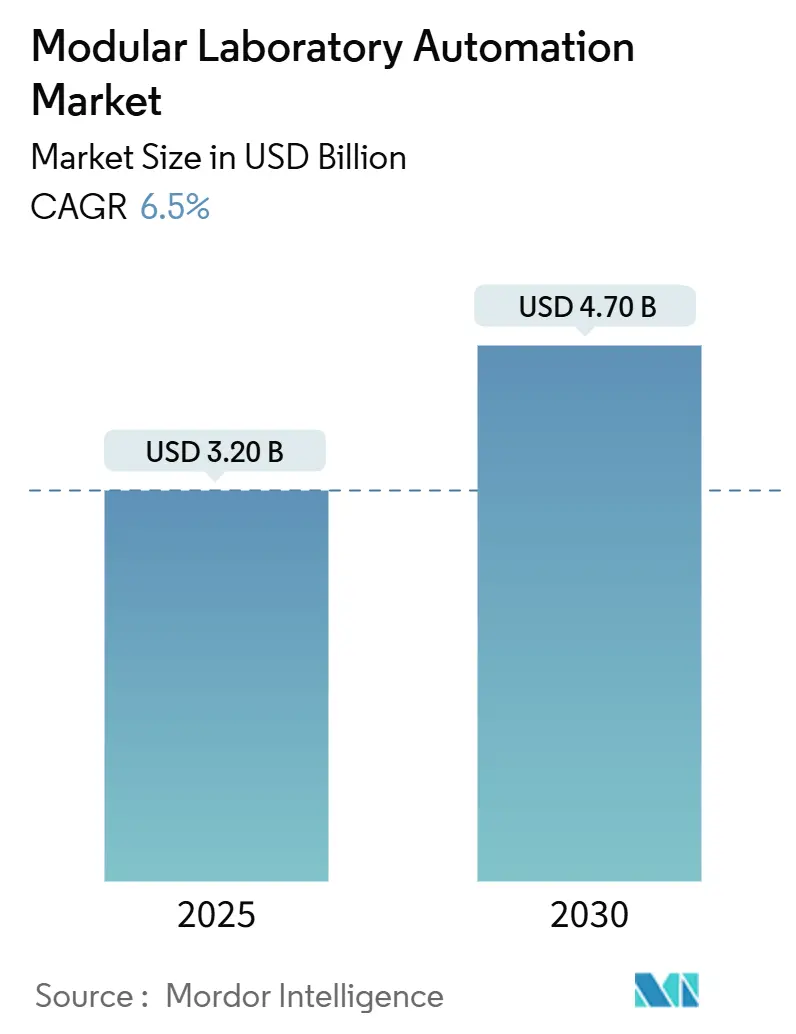
Modular Laboratory Automation Market Analysis by Mordor Intelligence
The modular laboratory automation market size is estimated at USD 3.2 billion in 2025 and is set to advance to USD 4.7 billion by 2030, translating to a 6.50% CAGR throughout the forecast window. Heightened regulatory scrutiny, a shrinking laboratory workforce, and the growing need for reproducible data position automated, network-ready work cells as critical infrastructure for life-science innovation. Suppliers now bundle artificial-intelligence software with robotics, allowing laboratories to standardize protocols, capture complete audit trails, and shorten testing cycles. Pharmaceutical manufacturers are accelerating adoption to satisfy the EU GMP Annex 1 contamination-control requirements, while hospital networks favour modular deployments that scale distributed testing without lengthy construction projects. In parallel, federal support such as the NIH MATChS program signals that laboratory automation is no longer discretionary but a strategic enabler for biomedical research.
Key Report Takeaways
- By equipment & software, automated liquid handlers accounted for 26.41% of the modular laboratory automation market share in 2024; automated storage & retrieval systems are on track for a 7.21% CAGR through 2030.
- By field of application, clinical diagnostics held 28.50% revenue share in 2024, while cell & gene therapy workflows are projected to expand at a 9.66% CAGR to 2030.
- By end user, pharmaceutical & biotech companies captured 32.20% of the modular laboratory automation market size in 2024; contract research organizations are forecast to grow at an 8.61% CAGR through 2030.
- By automation type, modular work cells led with 29.21% revenue share in 2024, whereas mobile/cloud-connected robots are set to grow at a 9.24% CAGR by 2030.
- By geography, North America commanded 41.70% of global revenue in 2024; the Asia–Pacific region is the fastest-growing territory through 2030.
Global Modular Laboratory Automation Market Trends and Insights
Drivers Impact Analysis
| Driver | (~) % Impact on CAGR Forecast | Geographic Relevance | Impact Timeline |
|---|---|---|---|
| Rising need for reproducibility & data integrity | +1.8% | Global, strongest in North America & Europe | Medium term (2-4 years) |
| Chronic skilled-labour shortages in life-science labs | +2.1% | Global, acute in North America & APAC | Short term (≤2 years) |
| High-throughput genomics & cell-therapy pipelines | +1.5% | North America & Europe, spreading to APAC | Medium term (2-4 years) |
| EU GMP Annex 1 contamination-control mandates | +1.2% | Europe with global spillover | Short term (≤2 years) |
| Source: Mordor Intelligence | |||
Rising Need for Reproducibility & Data Integrity
Automated platforms impose strict process control, cutting variability that manual techniques often introduce. The Mayo Clinic’s sorting system moves 6,000 tubes per hour without mis-sorts, demonstrating zero-defect data capture. Such results are indispensable as regulators demand granular audit trails for every assay. Multi-site consortia use standardized robotic workflows to compare results confidently, boosting collaborative studies. Vendors increasingly embed blockchain-ready logs to safeguard raw data. These capabilities elevate laboratory credibility when submitting evidence to regulatory agencies.
Chronic Skilled-Labor Shortages in Life-Science Labs
Vacancies nearing 25,000 positions across North America have pushed labs toward automation that reassigns repetitive tasks to machines while scientists focus on interpretation. Clarapath’s robotic microtomy lets one technician oversee multiple slide-prep stations, tripling output capacity. Such labour-multiplying benefits shorten testing backlogs and support 24/7 operations without overtime premiums. Automation also institutionalizes tacit knowledge by encoding protocols into software, reducing onboarding time for new hires. With retirement rates climbing, the economic rationale for modular laboratory automation market investments strengthens further. [1]Clarapath, “Clarapath Automates Slide Preparation and Microtomy Workflow,” The Dark Report, api.clarapath.com
High-Throughput Genomics & Cell-Therapy Pipelines
Large-scale sequencing studies and cell-therapy trials demand a pace impossible with manual pipetting. Automated liquid handlers now assemble sequencing libraries for thousands of samples in parallel, slashing per-sample cost. For CAR-T production, Danaher’s closed-loop robots maintain sterile boundaries while executing precise cell manipulations. Partnerships such as Astellas–YASKAWA leverage dual-arm robots to unify motion planning with inline analytics. The fusion of AI with machine-vision allows real-time error correction, pushing yields higher and reinforcing the modular laboratory automation market as the backbone of precision medicine manufacturing.
EU GMP Annex 1 Contamination-Control Mandates
Regulations effective since 2023 elevate robotics from optional to essential in sterile suites. New gloveless isolators integrate with autonomous arms that dispense, cap, and inspect vials without human contact. Continuous environmental monitoring sensors feed data into cloud dashboards that alert operators before particulates breach thresholds. Companies standardize on these robot-centric workflows globally, ensuring every batch meets the strictest jurisdiction. The regulatory tailwind accelerates procurement cycles, locking the modular laboratory automation market into long-term capital investment plans. [2]OPTIMA, “Annex 1 – Solutions for Successful Implementation,” OPTIMA, optima-packaging.com
Restraints Impact Analysis
| Restraint | (~) % Impact on CAGR Forecast | Geographic Relevance | Impact Timeline |
|---|---|---|---|
| High upfront capex & long ROI cycles | -1.4% | Global, hardest on smaller labs | Short term (≤2 years) |
| Integration complexity with legacy instruments & LIMS | -1.1% | Global, greater in mature markets | Medium term (2-4 years) |
| Source: Mordor Intelligence | |||
High Upfront Capex & Long ROI Cycles
Entry-level robotic benches cost USD 100,000–300,000, while full lines exceed USD 1 million, straining academic and midsize budgets. Payback often stretches past three years because benefits like error-free data or staff redeployment resist simple monetization. Leasing schemes and usage-based pricing partially lower the barrier, yet maintenance contracts, validation, and operator training still elevate total cost of ownership. Finance committees therefore stage investments in phases, favouring the modular laboratory automation market approach that lets sites bolt on capacity incrementally.
Integration Complexity with Legacy Instruments & LIMS
Many instruments pre-date modern APIs, forcing labs to build middleware that maps file formats and reconciles barcodes. Custom coding inflates project timelines and risks data silos if vendors change protocols. Cloud-native LIMS platforms promise plug-and-play connectivity, but migrating decades of historical results raises validation burdens. Without enterprise data governance plans, the full productivity gains of the modular laboratory automation market remain unrealized.
Segment Analysis
By Equipment and Software: Liquid Handlers Drive Market Foundation
Automated liquid handlers generated 26.41% of the modular laboratory automation market size in 2024, cementing their role as the backbone of assay preparation. Laboratories favour these platforms because precision pipetting ensures downstream data quality while freeing staff for analytical tasks. Demand for integrated software that optimizes deck layouts and predicts tip consumption is growing, reducing consumable waste and unplanned downtime. Automated storage & retrieval systems, projected to grow at 7.21% CAGR, solve the chronic challenge of sample archiving by delivering samples to work cells just-in-time. Vendors now combine low-temperature warehouses with AI route planning, minimizing freeze–thaw events and safeguarding biomolecule integrity.
Software innovation shapes competitive differentiation as vendors embed machine-learning algorithms that flag anomalies before assay failures propagate. Thermo Fisher’s Vulcan platform illustrates how combining robotic arms with self-tuning workflows elevates throughput. Analysers capable of inline mass spectrometry or fluorescence detection compress total turnaround time, letting labs condense multi-day protocols into single shifts. The net effect is a structural rise in demand for cohesive ecosystems rather than single-purpose boxes, reinforcing supplier emphasis on modular laboratory automation market ecosystems that orchestrate hardware and data in one pane of glass. [3]Thermo Fisher Scientific, “Thermo Fisher Scientific Reports First Quarter 2025 Results,” CACLP, en.caclp.com
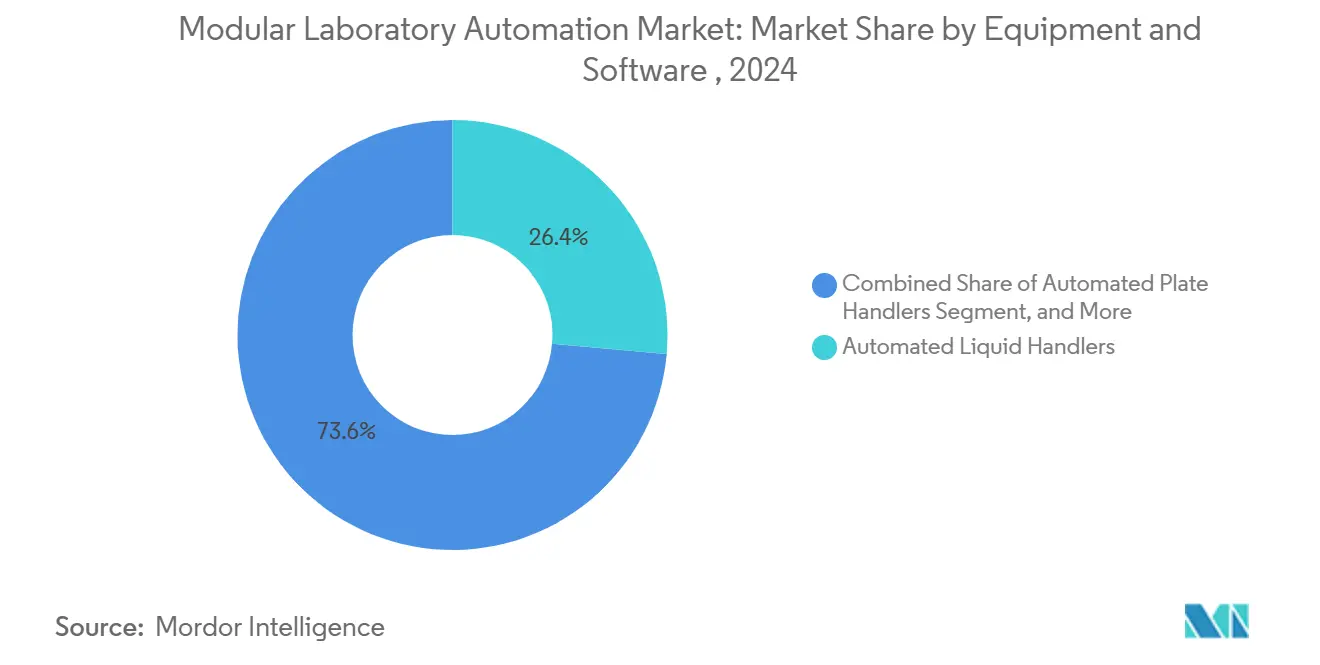
Note: Segment shares of all individual segments available upon report purchase
By Field of Application: Clinical Diagnostics Lead Automation Adoption
Clinical diagnostics contributed 28.50% revenue in 2024, underpinned by high-volume chemistries and strict accreditation criteria that reward reproducible automation. Hospital laboratories integrate conveyor-linked work cells with middleware that posts verified results directly to electronic health records, shortening patient care cycles. Cell & gene therapy workflows, forecast for 9.66% CAGR, need closed-system robots that minimize contamination risk during lengthy culture periods. Robots equipped with environmental sensors and AI classifiers maintain sub-micron cleanliness, preventing batch failures that could cost millions of USD.
Drug-discovery groups continue to deploy high-throughput screens on 1,536-well plates, while genomics consortia automate library prep for population cohorts. Proteomics is emerging as laboratories automate sample digestion and LC-MS loading. Cross-disciplinary platforms that support reagent-agnostic protocols are gaining traction, as they let sites pivot capacity between diagnostic, discovery, and manufacturing workloads. This versatility reinforces investment in the modular laboratory automation market because a single capital outlay serves many revenue streams.
By End User: Pharmaceutical & Biotech Companies Anchor Market Demand
Pharmaceutical and biotech firms captured 32.20% of 2024 spending, driven by regulatory obligations for data integrity and the need to compress development timelines. High-throughput biology paired with electronic batch records accelerates IND submissions and reduces failure risk in late-stage trials. CROs, expanding at an 8.61% CAGR, deploy flexible automation that handles client-specific methods without long validation cycles. Their purchasing power incentivizes vendors to standardize plug-ins that swap liquid classes and deck configurations in minutes.
Academic institutes adopt modular work cells to stretch limited grants yet still meet peer-review expectations for reproducibility. Clinical laboratories, pressured by test-volume growth and workforce gaps, use pre-analytical robots that decamp tubes and aliquot specimens automatically. Food and environmental laws require ruggedized systems that resist acidic or particulate-laden samples; this niche sustains a specialized subset within the modular laboratory automation market, often delivered as compact benchtop units.
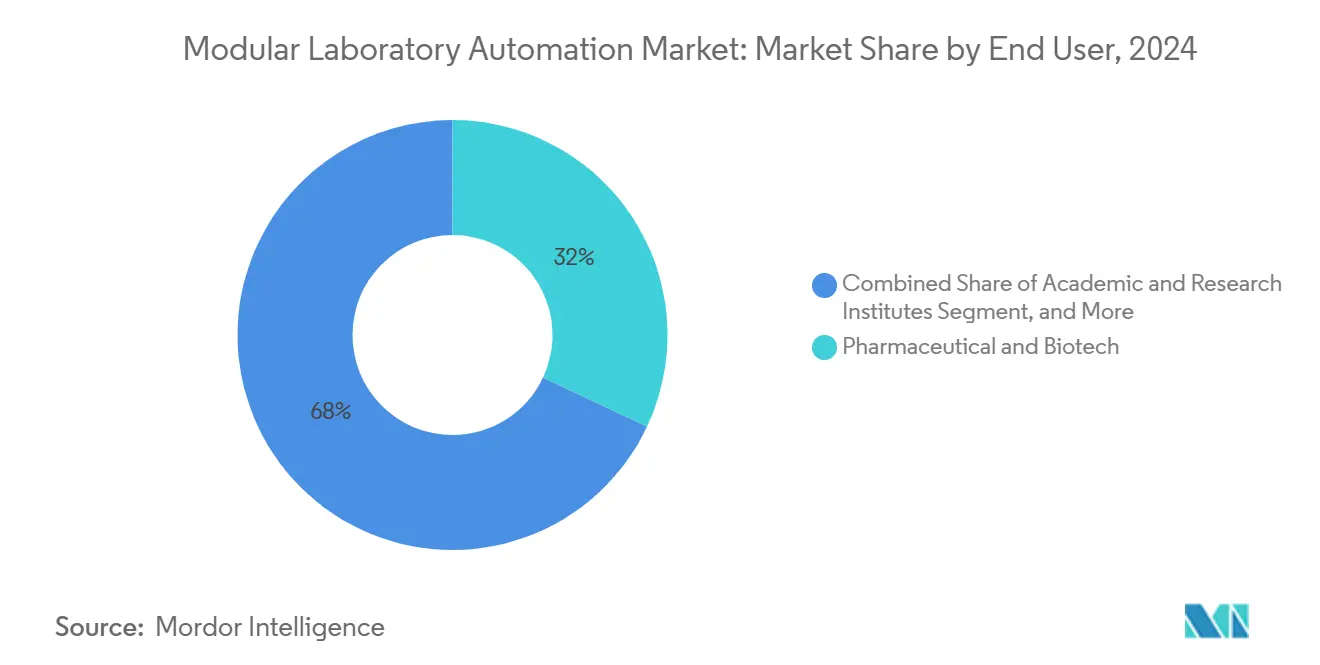
Note: Segment shares of all individual segments available upon report purchase
By Automation Type: Modular Work cells Balance Flexibility and Integration
Modular work cells accounted for 29.21% of revenue in 2024, validating the premise that stepwise deployment balances cost and capability. Laboratories often start with a liquid-handling core, add plate movers, then integrate analytics as volumes scale. Mobile or cloud-connected robots, expected to expand at a 9.24% CAGR, traverse multiple benches and share resources across departments, making capital use more efficient. Their onboard cameras support remote service diagnostics, a feature valued in geographically dispersed networks.
Standalone instrument automation remains relevant where single-analysis precision outweighs throughput. Integrated work cells deliver linear sample paths ideal for reference laboratories with predictable demand curves. Total laboratory automation lines occupy the premium tier; although costly, they virtually eliminate human touch points, achieving the highest possible workflow velocity. Regardless of configuration, security-hardened firmware and role-based access control are now standard, reflecting cybersecurity expectations in the modular laboratory automation market.
Geography Analysis
North America sustained a 41.70% revenue share in 2024, reflecting the concentration of biopharmaceutical headquarters, generous NIH funding, and a mature regulatory environment that favours technology investments. Recent federal grants, such as the USD 2.15 million MATChS award, confirm public-sector endorsement of intelligent automation. Tier-1 hospitals are integrating decentralized work cells, pushing specimen processing closer to patient intake to reduce logistics delays. Canada’s life-science clusters leverage provincial tax credits to upgrade research infrastructure, though staffing shortages remain acute; automation therefore offers a pragmatic path to maintain throughput despite limited headcount. Mexico, seeking export accreditation for sterile injectables, is piloting robotic isolators to meet Annex 1 requirements and secure contract manufacturing deals. [4]National Institutes of Health, “Miniaturization and Automation of Tissue Chip Systems (MATChS),” National Institutes of Health, grants.nih.gov
Asia–Pacific registers the highest growth trajectory as governments subsidize biotech infrastructure and encourage local manufacturing of advanced therapies. China invests in national sequencing hubs that adopt fully automated, closed-loop pipelines, reducing per-genome costs and accelerating precision-medicine pilot programs. Japan’s aging population elevates demand for diagnostic automation capable of handling chronic-disease panels. India’s contract-manufacturing sector implements modular isolators that comply with global sterility standards, positioning domestic plants for regulated-market exports. South Korea focuses on cell-therapy centers of excellence that combine dual-arm robots with AI analytics, bringing complex biologics to market more swiftly. Collectively, these initiatives underpin sustained demand across the modular laboratory automation market throughout the region.
Europe remains a pivotal market because Annex 1 lifts technical barriers in favour of robotics, driving upgrades across legacy fill-finish lines. Germany’s engineering base integrates high-precision mechatronics with cloud-native MES platforms, while the United Kingdom channels research funding into university-hospital partnerships that validate AI-directed work cells. France modernizes public-sector laboratories through stimulus packages that offset upfront capex. Italy and Spain prioritize total laboratory automation in blood-bank operations to curb transfusion errors. The regulatory commonality across the European Economic Area encourages cross-border standardization, letting suppliers offer uniform validation packages and thereby expedite procurement across multiple sites within the modular laboratory automation market.
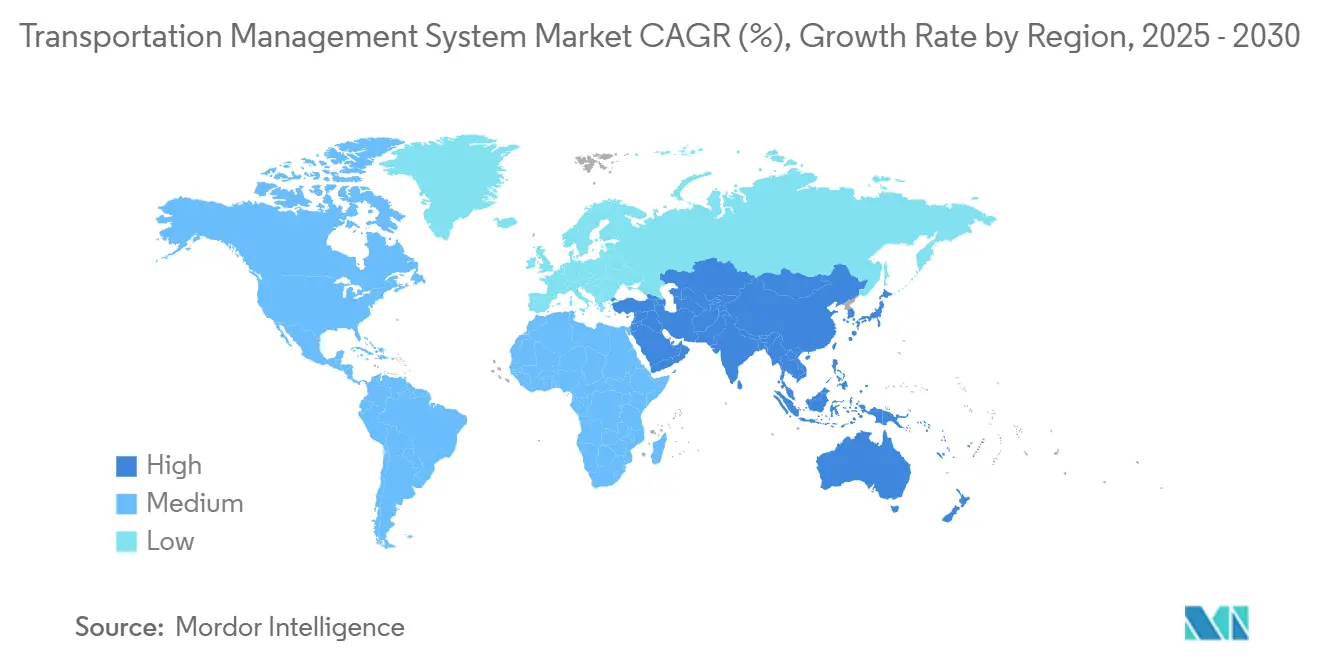
Competitive Landscape
The modular laboratory automation market shows moderate consolidation; the top three suppliers hold substantial but not monopolistic positions. Thermo Fisher integrates robotics, consumables, and cloud software into turnkey offerings, as reflected in its USD 10.36 billion Q1 2025 revenue. Danaher advances AI-assisted workflows that predict assay failures and auto-correct pipetting parameters, shielding clients from costly reruns. Tecan leverages open-API policies to foster third-party ecosystem growth, a key attraction for institutes blending legacy instruments with new automation.
Strategic acquisitions intensify competition. Siemens’ USD 5.1 billion purchase of Dotmatics injects AI LIMS capabilities that converge design, execution, and data analytics under one roof. Grifols teams with Inpeco to unveil FlexLab X, bringing transfusion medicine into the era of open automation. QuidelOrtho pursues rapid molecular diagnostics that dovetail with existing chemistry-analyser fleets, expanding footprint without fresh floor-space commitments. Start-ups differentiate through mobile robotics and service-based pricing, appealing to mid-tier labs that resist heavy capital outlays.
Cybersecurity emerges as a new battleground. Vendors harden firmware, embed encrypted communications, and offer SOC-as-a-service to reassure regulated industries. Ecosystem partnerships also matter; consumables suppliers co-design reagent kits optimized for specific robot platforms, locking in recurring revenue. In this environment, vendor ability to deliver validated, end-to-end solutions will determine share capture within the modular laboratory automation market over the next five years.
Modular Laboratory Automation Industry Leaders
Thermo Fisher Scientific
Danaher (Beckman Coulter)
Tecan Group AG
Agilent Technologies
Hamilton Company
- *Disclaimer: Major Players sorted in no particular order
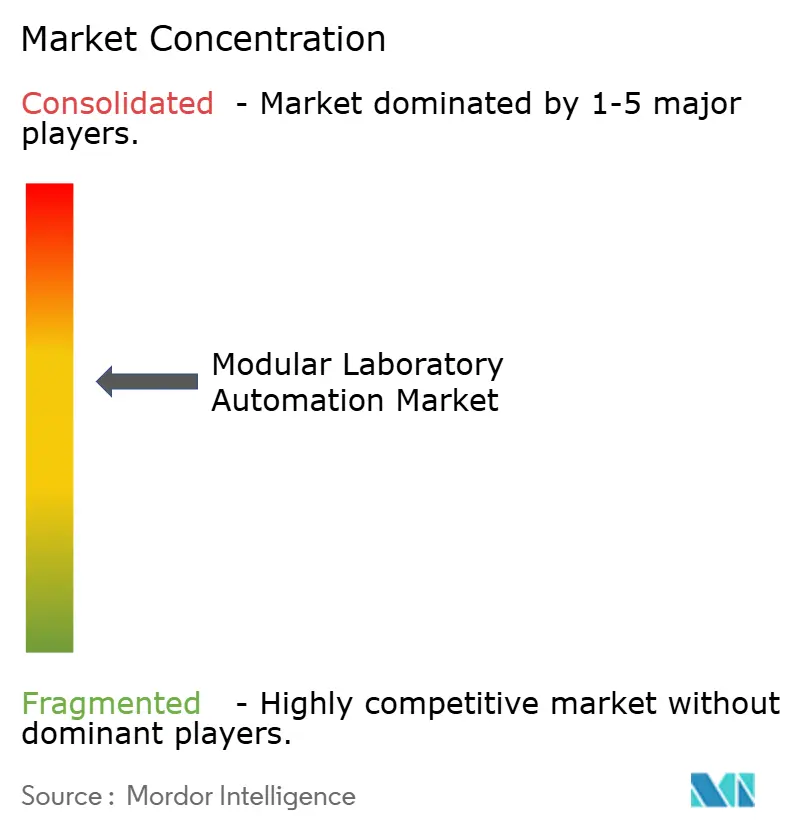
Recent Industry Developments
- June 2025: QuidelOrtho Corporation announced its plan to acquire LEX Diagnostics after FDA clearance, expanding point-of-care molecular testing portfolios that integrate seamlessly with automated lab workflows.
- May 2025: Thermo Fisher Scientific completed the USD 4.1 billion acquisition of Solventum’s Purification & Filtration business to broaden sample-preparation automation.
- April 2025: Siemens AG acquired Dotmatics for USD 5.1 billion to enhance AI-driven software suites that unify laboratory data pipelines.
- March 2025: Astellas Pharma and YASKAWA Electric formed a joint venture to develop dual-arm robot systems for precision cell-therapy manufacturing.
Research Methodology Framework and Report Scope
Market Definitions and Key Coverage
Our study defines the modular laboratory automation market as the sale of discrete, factory-built workcells, robotic arms, automated liquid or plate handlers, storage and retrieval modules, and orchestration software that slot into existing benches to automate selected workflow steps without requiring a full conveyor-based total-lab line.
(Scope Exclusion) Stand-alone benchtop readers, pure-play LIMS platforms, and end-to-end TLA tracks lie outside this assessment.
Segmentation Overview
- By Equipment and Software
- Automated Liquid Handlers
- Automated Plate Handlers
- Robotic Arms
- Automated Storage and Retrieval Systems (ASRS)
- Analyzers
- Software
- By Field of Application
- Drug Discovery
- Genomics
- Proteomics
- Clinical Diagnostics
- Other Applications
- By End User
- Pharmaceutical and Biotech Companies
- Academic and Research Institutes
- Clinical and Diagnostic Laboratories
- Contract Research Organisations
- Food and Environmental Testing Labs
- By Automation Type
- Standalone Instrument Automation
- Modular Workcells
- Integrated Workcells
- Total Laboratory Automation (TLA) Lines
- Mobile/Cloud-connected Robots
- By Geography
- North America
- United States
- Canada
- Mexico
- South America
- Brazil
- Argentina
- Rest of South America
- Europe
- United Kingdom
- Germany
- France
- Italy
- Russia
- Rest of Europe
- Asia-Pacific
- China
- Japan
- India
- South Korea
- Rest of Asia-Pacific
- Middle East
- Israel
- Saudi Arabia
- United Arab Emirates
- Turkey
- Rest of Middle East
- Africa
- South Africa
- Egypt
- Rest of Africa
- North America
Detailed Research Methodology and Data Validation
Desk Research
We started with open statistics from UN Comtrade, FDA 510(k) device clearances, EMA guidance notes, and adoption surveys published by the International Society for Automation. We then layered in patent counts from Questel and production snapshots in peer-reviewed journals such as Nature Methods. Company 10-Ks, capital expenditure transcripts, and reputable press helped map investment cycles and typical module prices. Paid repositories, including D&B Hoovers for revenue splits and Dow Jones Factiva for shipment news, rounded out vendor intelligence. The sources named illustrate our approach; many other public and subscription inputs informed data collection and consistency checks.
Primary Research
Mordor analysts interviewed automation engineers at hospital labs, process development scientists in pharma, regional distributors in East Asia, and procurement heads at CROs. These conversations clarified real-world throughput limits, utilization patterns, and buying triggers, allowing us to reconcile divergent viewpoints through follow-up surveys.
Market-Sizing & Forecasting
A top-down build of installed base replacement cycles, high-throughput sample volumes, and laboratory capital budgets produced the initial pool. Selective bottom-up shipment checks, sampled ASP multiplied by volume, validated and adjusted totals. Key variables include global pharma R&D spend, the count of CLIA-certified labs, median liquid handler ASP erosion, uptake of cell and gene therapy assays, and regional skilled labor shortages. Multivariate regression with scenario analysis generated 2026 to 2030 forecasts, while gaps in distributor data were bridged with weighted regional averages.
Data Validation & Update Cycle
Before release, our team runs variance tests against vendor order backlogs, import codes, and currency shifts. Anomalies trigger re-contact of subject matter experts. Models refresh annually, with interim updates for material events, ensuring clients receive the latest view.
Why Mordor's Modular Laboratory Automation Baseline Commands Reliability
Published estimates often diverge because firms apply different module baskets, price assumptions, and calendar cut-offs. Our disciplined scope alignment and yearly bottom-up sense checks keep the baseline steady.
Key gap drivers include narrower geography coverage by some publishers, exclusion of coordinating software in others, and static ASP use that ignores rapid robotics price deflation.
Benchmark comparison
| Market Size | Anonymized source | Primary gap driver |
|---|---|---|
| USD 3.20 B (2025) | Mordor Intelligence | |
| USD 2.50 B (2025) | Global Consultancy A | Omits software modules and South America, lowering totals |
| USD 3.20 B (2024) | Trade Journal B | Uses 2024 exchange rates and excludes distributor mark-ups |
The comparison shows that, once scope, geography, and pricing are normalized, Mordor's 2025 figure provides a balanced, transparent baseline that decision-makers can trace back to clear variables and repeatable steps.
Key Questions Answered in the Report
What is the current size of the modular laboratory automation market?
The modular laboratory automation market stands at USD 3.2 billion in 2025 and is projected to reach USD 4.7 billion by 2030.
Which segment holds the largest share of the modular laboratory automation market?
Automated liquid handlers lead with 26.41% revenue share, reflecting their central role in most laboratory workflows.
Why are pharmaceutical companies investing heavily in modular laboratory automation systems?
Pharmaceutical firms need reproducible data, regulatory compliance, and accelerated development timelines; modular automation delivers these benefits while supporting high-throughput screening and sterile manufacturing requirements.
How do EU GMP Annex 1 requirements influence automation purchasing decisions?
The revised guideline favours robotic isolators and continuous monitoring, prompting European and global manufacturers to invest in automation that ensures contamination control.
What financial barriers do smaller laboratories face when adopting automation?
Upfront capital costs can exceed USD 1 million, and ROI may extend beyond three years, making leasing or phased deployment attractive alternatives.
How are cybersecurity concerns addressed in networked laboratory robots?
Vendors embed encrypted communications, role-based access controls, and offer security-operations-center services to mitigate unauthorized access risks in connected automation systems.



